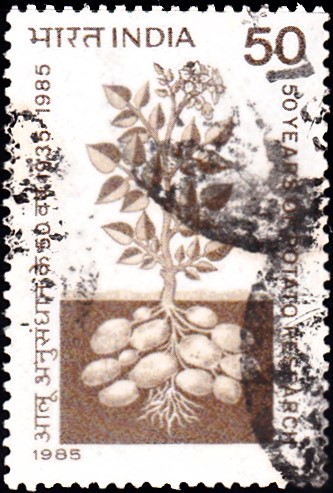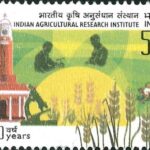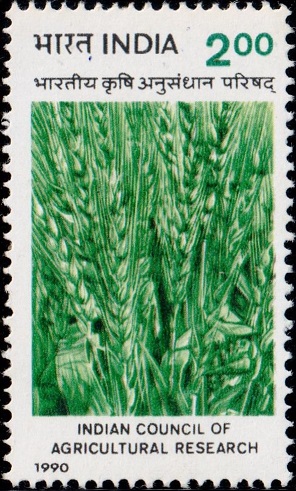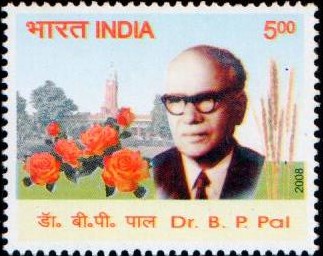
India on Potato Research
A commemorative postage stamp on the 50th Anniversary of the Potato Research in India :
 Issued by India
Issued by India
Issued on Apr 1, 1985
Issued for : The Department of Posts is pleased to honour this magnificent achievement of Indian Agriculture by issuing a commemorative stamp on 1 April 1985, the date heralding 50 years of Potato Research in India.
Description of Designs : The design for the stamp has been prepared by the Art Unit of the Indian Council of Agricultural Research, New Delhi. The First Day Cover shows tubers of Kufri Jyoti, a popular cultivar. The cancellation has been designed by Nenu Bagga.
Type : Stamp, Postal Used
Colour : Brown
Denomination : 50 Paise
Overall size : 4.06 x 2.73 cms.
Printing size : 3.71 x 2.38 cms.
Perforation : 13 x 13
Paper : Unwatermarked P.G. Matt coated paper
Number printed : 15,00,000
Number per issue sheet : 40
Printing process : Photogravure
Printed at : India Security Press
About :
- The Potato is a native of the Andean tropical highlands of South America, from where it was taken to Europe in the sixteenth century by the Spanish conquistadors. Within the next 50 years it appears to have been brought to India by the Portuguese, or perhaps the Spanish. In an account of the travels through India during (1615-1617) Edward Terry-chaplin to Sir Thomas Roe, Ambassador of the East India Company to the Mughal Court, states that he found potato being grown “everywhere……..in the northern most parts of the Empire“.
- The root and tuber crops which include the potato, yams, arums, sweet potato and cassava constitute one of the most important foods of man alongwith rice, wheat, maize and millets. These plants can grow in a wide variety of conditions including marginal soils and produce the highest rates of dry matter, for each day that they grow in the field. They are rich in energy-giving carbohydrates and also in several essential minerals and vitamins. They are also used widely, particularly in Europe and North America, as an animal feed and in industry for making alcohol, sugars etc.
- During 1983-84, potato was grown in India in 806,000 ha and the production amounted to 12.25 million tonnes. The per hectare production came to 15.2 tonnes and the per caput production to about 15 kg per year. In 1950-51 the respective figures were, area: 2,40,000 ha; production 1.66 million tonnes; Yield: 6.9 tonnes/ha; and per caput production: 4.6 kg per year. Thus in the last 34 years potato has registered 3.4 fold increase in area, 7.4 fold increase in production, 2.2 fold increase in yield, and 3.3 fold increase in per caput production. This is indeed a most remarkable achievement. Today, potato is grown in almost all major States of India. Two thirds of the area under cultivation lies in the Indo-Gangetic plains covering mainly Uttar Pradesh, Bengal and Bihar. These achievements have become possible due to the sustained accomplishments of potato research in the country.
- Organised potato research began in India on 1 April, 1935 with the opening of three breeding and seed production stations at Simla, Kufri (both Simla hills) and Bhowali (Kumaon hills), under the Indian (then Imperical) Agricultural Research Institute, New Delhi. Realising the potential of potato in this country the Govt. of India established the Central Potato Research Institute (CPRI) in 1949, with Patna as its headquarters. In 1956, the headquarters were shifted to Simla. At present, potato research and development in the country is carried out by the CPRI and its 12 Research Stations located in different parts of India and the All India Coordinated Potato Improvement Project (AICPIP), begun by the Indian Council of Agricultural Research in 1972. The AICPIP has 16 Coordinating Centres located in the State Agricultural Universities.
- The most important achievements of potato research in India are: (i) evolution and release of 23 improved cultivars. The most popular among them are Kufri Chandramukhi, Kufri Jyoti, Kufri Sindhuri, and more recently, Kufri Bahar, Kufri Badshah and Kufri Lalima; (ii) development of a scientific seed production programme in the country. At present, it distributes over 2000 tonnes of breeders seed of various improved cultivars annually; (iii) development of a method to produce healthy seed in the plains; (iv) survey and identification of important diseases and pests infecting potato and developing suitable control measures for them; and (v) development of package of practices for producing seed and table potatoes in different zones of the country.







